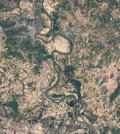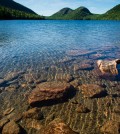Posts for tag "chlorophyll"
Charles River Algal Blooms Stop Swimming and Launch a Floating Wetland
After decades of abuse, new research and a floating wetland point toward a healthier future for the Charles River.
- Posted April 7, 2021
Lake Superior Algal Blooms Surprise, Highlight Need for More Monitoring
Algal blooms showed up unexpectedly in Lake Superior. Researchers pieced together their cause and are on the lookout for future blooms.
- Posted October 21, 2020
Buoy Monitoring for Red Tide, Students Watching Sea Level Rise
Florida International University is deploying a data buoy to monitor for red tide, and educating citizen scientists on sea level rise.
- Posted March 27, 2019
Ohio’s Stream Nutrient Assessment Procedure Tracks State’s Nutrient Levels
Using automated data loggers, fluorometry probes and other equipment, Ohio EPA scientists work to define harmful stream nutrient levels.
- Posted December 17, 2015
Nitrogen Dynamics: In The Field With Scientists Tackling Dual Nutrient Questions
With more support for dual nutrient management strategies, Wright State researchers show us how they’re studying nitrogen’s role in runoff and algal blooms.
- Posted October 23, 2015
Enhanced Free-Floating Sensors Join Argo Network In Indian Ocean
Scientists with Australia’s Commonwealth Science and Industrial Research Organization launched new floating sensors in July that join the Argo network collecting data on the Indian Ocean, according to The Guardian. The new sensors can dive down to...
- Posted July 14, 2015
Modeling Ohio River chlorophyll using satellite imagery
Researchers at Marshall University use satellite imagery and grab samples to develop a model of the Ohio River’s chlorophyll levels.
- Posted June 2, 2015
Upcoming Hudson River research center will offer estuary data to public and scientists
A new research center on the Hudson River's Pier 26 in Manhattan will provide valuable data while educating the public on the significance of the estuary.
- Posted January 14, 2015
Beaufort Sea study seeks to prospect and protect complex Arctic ecosystem
Federal, private sector and international partners are studying the Beaufort Sea to uncover the Arctic ecosystem's potential for responsible human use.
- Posted January 5, 2015
REON II water quality network gets upgrade for Hudson, St. Lawrence watersheds
The Beacon Institute’s new low-cost REON II water quality sensor package could boost monitoring in the Hudson and St. Lawrence watersheds and beyond.
- Posted December 29, 2014
New Rotorua Te Arawa Lakes data buoy tracks polymictic lake’s oxygen dynamics
A data buoy launched in New Zealand’s Lake Rerewhakaaitu will provide scientists with insights into the polymictic lake’s oxygen dynamics and production.
- Posted December 16, 2014
300,000-gallon sewage spill has surprisingly minor impacts in Maryland’s Mill Creek
An ongoing monitoring program on Maryland's Mill Creek helped show a 300,000-gallon sewage spill into the headwaters had a surprisingly small impact.
- Posted December 6, 2014
Private effort aims to wire Lake George into world’s ‘smartest lake’
Some of the same engineers behind IBM's Jeopardy-winning Watson are turning to water monitoring tech to make Lake George the world's 'smartest lake.'
- Posted October 28, 2014
Data buoy on Acadia National Park’s Jordan Pond to help answer clarity questions
Famous for its clarity, Jordan Pond in Acadia National Park is getting a little cloudier. A data buoy is helping scientists and managers find out why.
- Posted October 24, 2014
On Highland Lake, data buoy to help answer stratification questions
An anonymously funded data buoy on Maine's Highland Lake will help answer questions about stratification, deep oxygen and phosphorus recycling.
- Posted October 15, 2014
New fleet of drifting ocean profilers to monitor waters around Antarctica
A new fleet of drifting ocean profilers will monitor the Southern Ocean, which absorbs much of the Earth’s excess heat and human carbon emissions.
- Posted October 13, 2014
Delaware Bay Estuary’s zooplankton getting a closer look for first time in 60 years
University of Delaware researchers are amassing a visual library of zooplankton in the Delaware Bay Estuary and collecting water quality data along the way.
- Posted September 9, 2014
Ocean Observatories Initiative profilers enable new generation of research below the surface
After a decade of planning, the Ocean Observatories Initiative’s first deployment of cabled ocean profilers begins this July in the northeast Pacific.
- Posted April 8, 2014




















